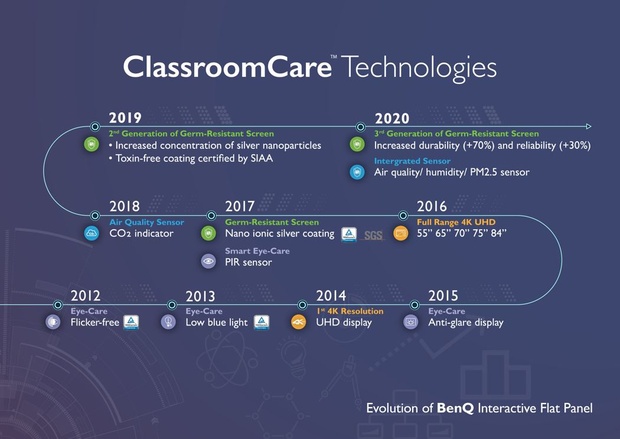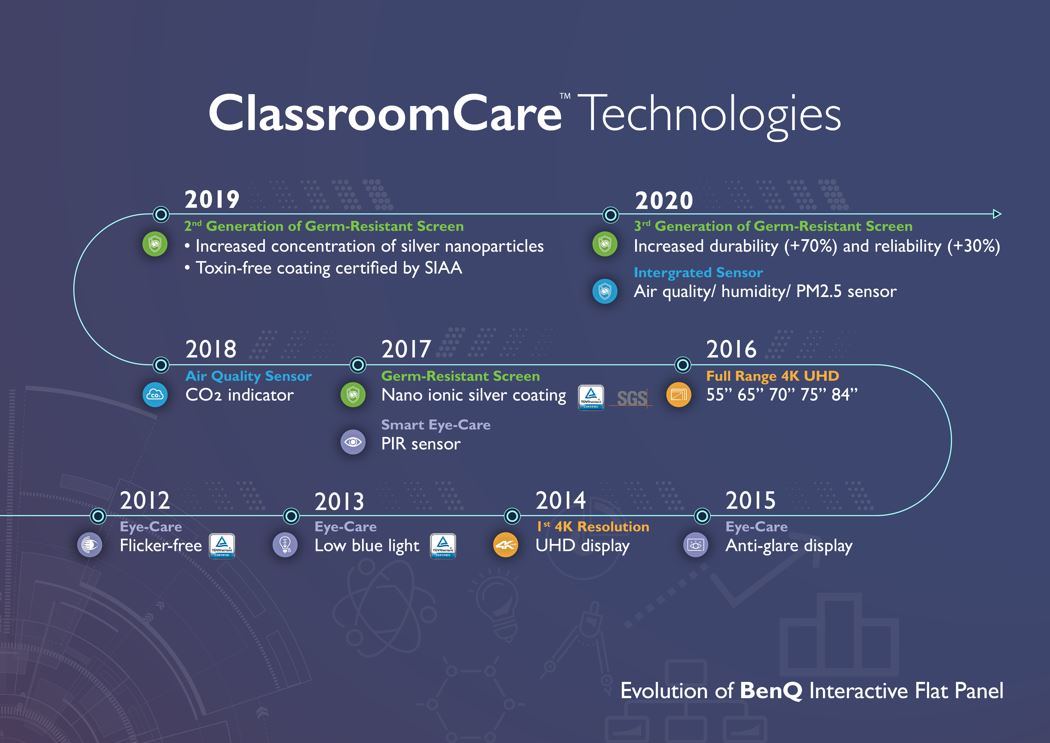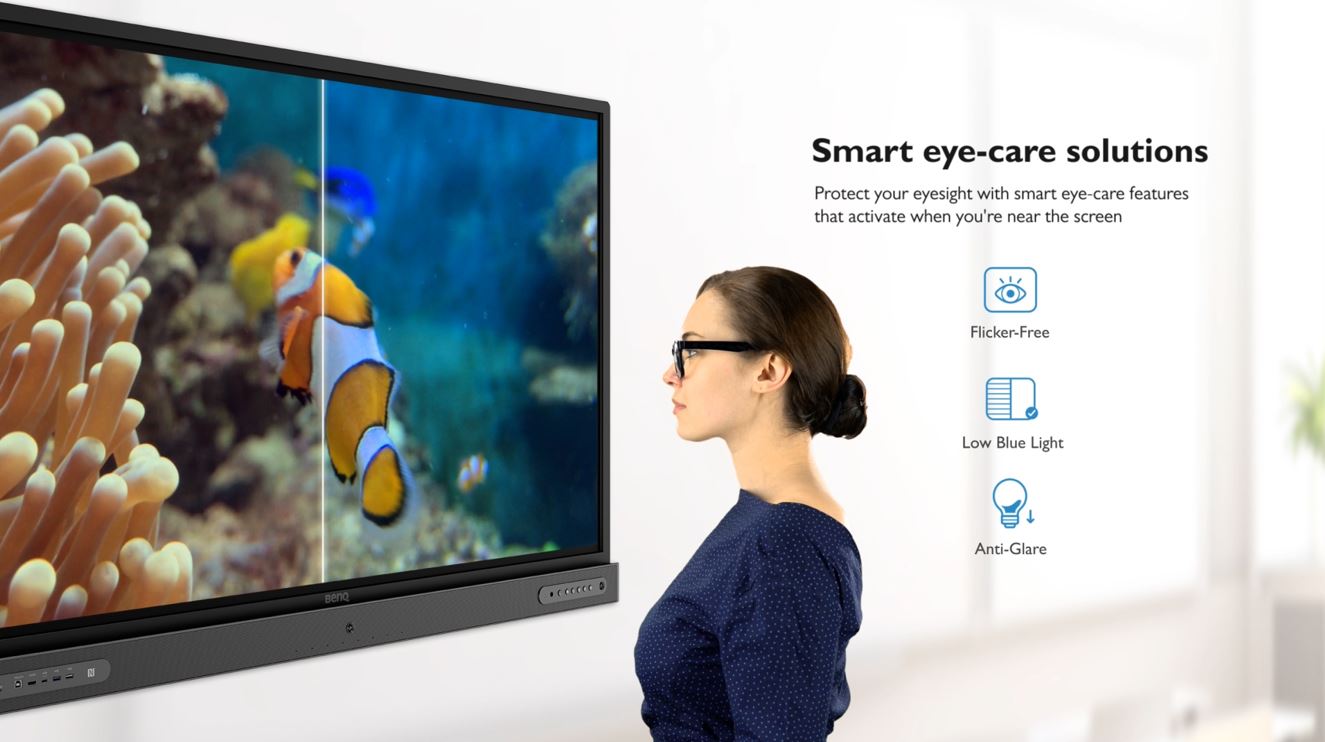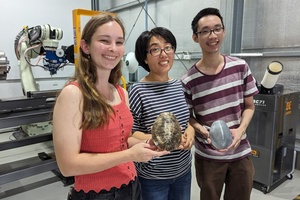The brand’s flourishing reputation in edtech circles has solidified over this time, as BenQ’s focus has zeroed in on ensuring their evolving technology solutions not only enrich teacher pedagogy and boost learning, but also safeguard the health and wellbeing of staff and students.
And on the verge of their 20th anniversary, BenQ is celebrating their journey – one powered by innovation and a steely commitment to quality.
So, let’s dive in, shall we?
The ClassroomCare® assurance
If you’re not familiar with BenQ’s ClassroomCare® quality assurance tag, you probably should be. While the COVID-19 pandemic has ushered in a new and fully heightened awareness of health and hygiene standards in public spaces, BenQ have had this at the very centre of their operations since 2012 – the year ClassroomCare® was born.
From interactive displays that come with germ-resistant screens and advanced eyecare solutions, to air-quality sensors that make health a visible priority for the whole classroom, BenQ uses cutting-edge technology to make schools healthier and happier.
It has probably never been a more critical time for this. As schools around the country switch in and out of lockdown, and the world learns how campuses can turn into key sites of COVID-19 transmission, with new strains of the virus emerging, improving the safety of our schools has taken on a new urgency. BenQ is here to assist.
BenQ’s revolutionary Interactive Flat Panel technology has been used and enjoyed worldwide for a decade. Naturally, the line of interactive displays have morphed into a suite of products that comes with all the trimmings.
Described to facilitate a “truly healthy and collaborative learning experience” in the classroom, BenQ’s 4K UHD education interactive flat panel displays are new smart board features that boast a proven germ resistant screen, plus the handy digital whiteboarding and collaboration tool EZWrite, as well as InstaShare – a wireless screen mirroring and casting app. Say hello to truly effective blended learning, STEAM and project-based learning projects. Let’s unpack this further...

Revolutionary Interactive Flat Panel technology
Leading the way since day one, BenQ interactive displays were the first in Australia to include advanced eye-care features like flicker-free technology and low blue light, 4K resolution and CO2 monitoring. Other brands are now following suit.
Sticking true to the ClassroomCare® promise, all BenQ smart interactive display screens come with a multilayer coating of a non-toxic, enduring nano ionic silver agent that kills most germs which accumulate on touch screen surfaces. Expect your BenQ screen to have longer lasting anti-bacterial properties than any other conventional germ-defiant screen or spray on the market.
The promise doesn’t end there, however. Armed with the Smart Eye-Care solution function, BenQ interactive smart board displays will automatically activate flicker-free and low blue light features thanks to an embedded motion sensor. Once movement is detected close to the screen, Smart Eye-Care kicks in to give students more comfort, lessening any strain on their eyes that comes with prolonged screen time.
Now to the nitty gritty technical features. Exclusive to the BenQ interactive smart board is EZWrite, a powerful and handy app that ignites interactive learning with just one tap. Preloaded with multiple features, including MS Office compatibility, handwriting recognition, video recording and collaboration tools, EZWrite is your best friend when it comes to collaborative learning.
Meanwhile, InstaShare software that allows for seamless wireless presentation and collaboration during lectures makes the user experience even better. Prepare for the smooth streaming of visual and audio files, plus Full HD-quality videos. Students can also mirror content from their devices, and invite up to 16 peers for flawless online collaboration. Boom!
With many schools rolling with the punches of remote learning this term, now is the time to take full advantage of EZWrite Live Whiteboarding – a web-based whiteboard-ing and video conferencing platform designed specifically for blended and remote learning.
Add the Smart Projector into the mix and educators can connect with students in real time as they engage in classes, bringing their faces right into the room for the ultimate collaborative experience.
Ensuring your classroom air quality is safe
As experts urgently call for better indoor air quality standards to be set in schools across Australia, BenQ is once again on the front foot of the health advice. Before the risks associated with poor ventilation came to the forefront of public consciousness during the COVID-19 pandemic, BenQ had the issue of air quality high on the radar.
Air pollution might be usually associated with dense factory fumes and smoggy road traffic, but classrooms can also be a source of hazardous emissions. You might be surprised to learn that EPA studies have revealed that indoor levels of pollutants may be two to five times — and occasionally more than 100 times — higher than those outside.
Given most K-12 students spend about 1000 hours in the classroom every year, making sure indoor air quality is kept at an optimum level is critical.
Classroom ventilation in a pandemic
The good news is that BenQ’s ClassroomCare® technology is here to help schools ensure their classroom microclimate is safe. But first, let’s dive in to what we now know about the spread of COVID-19 and poorly ventilated indoor spaces.
Currently, health experts have identified three ways the virus is spread.
- Contaminated surfaces – through particles called ‘fomites’;
- Droplets – larger than 300 micrometres, these are produced when speaking, coughing, singing or sneezing and spread the virus when inhaled by others nearby;
- Aerosols – minute contagious particles are less than 100 micrometres in diameter, which are exhaled by an infectious person.
Of the three modes of transmission, experts agree aerosols pose the highest risk. In an unventilated indoor environment, aerosols can remain lingering in the air for hours. With each droplet, approximately 1200 aerosols are released. And without adequate ventilation, these build up over time – an invisible haze of contagion is the result.
What educators need is data to act on - key environmental parameters that can be measured and monitored in real time - in every classroom situation. Enter BenQ’s new smartboard, The Classroom Care® Interactive Flat Panel, which comes with in-built air quality sensors.
Educators can measure and monitor temperature, humidity, PM 2.5, P10, CO2 and VOC concentration levels via the display. Armed with this information, teachers can then intervene with appropriate actions, such as opening windows or adjusting air conditioning.
Then there’s the other side of the classroom air quality equation: poor air is not only detrimental to children’s health, but also their ability to learn.
Often crowded, overheated and poorly ventilated, classrooms excel at increasing the generation of carbon dioxide (CO2) in the air. When acceptable levels of CO2 tip over, things like headaches, nausea, poor concentration and blurred vision kick in. Let’s not forget the risks posed by volatile organic compounds (VOC’s) that are released by building materials, paints, furnishings and cleaning materials. To put it bluntly: there is no safe level of exposure to VOC’s, according to the World Health Organisation.
To top things off, particulate matter (PM 2.5 and PM10) which come typically from heating systems can also impact air quality, leading to coughing, eye irritation, allergies, asthma and headaches among other well-documented effects.
Growing young minds also bear the brunt of poor quality air. A growing body of research has flagged the harmful ways in which stuffy classrooms can alter student learning. Studies by the U.S. Environmental Protection Agency (EPA) have discovered that “even modest changes in room temperature affect students’ abilities to perform tasks requiring mental concentration”. In one study, students in US classrooms with better ventilation scored 14 to 15 percent higher on standardised tests.
With all this in mind, BenQ is more committed than ever to championing classroom technology that works to improve the physical learning environment for all students and staff on campus. And with just on 20 years behind this mission, BenQ have no plans to change their clear vision for Australian schools anytime soon.















